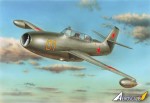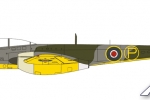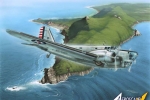Wednesday, February 06, 2013 - 09:41 AM UTC
MPM Production hit the New Year running with a bevy of exciting new releases, with more due later this month:
65 P-70 Nighthawk 1/72
The first US night fighter was converted from the A-20 light bomber aircraft. During its development many British experiences with radars and night fighting tactics were reflected. Until P-61 Black Widows were deployed, these P-70s served not only for training in USA mainland but were also deployed to Pacific Theater of Operations. They flew night fighter missions, night bomber raids against ground targets and convoy disruption missions there.
The kit of this night fighter contains six sprues with grey plastic parts and injected clear sprue. Decals included offer markings for 4 overall black machines. There of them served in PTO; the well known P-70 nicknamed “Dusty” with various nose arts, machine no. 165/9775 and no. 9785 nicknamed “Black Magic”. The latter one is of particular interest since its camouflage was repaired and so it combines faded matt And fresh glossy black color.
74 Gloster Meteor Trent „First Turboprop Fighter“1/72
Gloster Meteor became the first combat used jet fighter aircraft used by Allies during the WW 2.
During the rapid development of the jet technology during the war and right after its end
Meteor also served as a test bed for various jet engines trials. One of the Meteor versions that
doesn't fit into the latter description is Meteor Trent, which was a propeller powered Meteor.
Machine EE227 was converted from Meteor Mk.I; the turboprop Trent units driving five bladed
propellers were installed in the wing. To ensure directional stability two small auxiliary fins towards the outboard ends of the tailplanes were installed, also the undercarriage was heightened. The World's first turboprop fighter aircraft took off for the first time on September 20, 1945.
The kit contains three sprues with grey plastic parts, injected canopy and detailed resin parts. Decals included contain markings for EE227 prototype.
2228 B-18A Bolo „At War“ 1/72
According to 1934 specifications issued by USAAC High command B-18 Bolo was designed. The DB-1 (factory designation) design was derived from the design of the famous civil Dc-2 aircraft.
Unlike Dc-2, the DB-1 was mid-wing design with bomb bay located in the fuselage under the wing's cross section and defensive armament consisting of three 7.65 mm machine guns located in manually
operated nose and dorsal turrets and one in ventral hatch. Except of the initial batch later on, additional machines were ordered under designation B-18A. These new machines featured new, picked nose and new dorsal turret. In total 350 B-18s were ordered but only 312 machines were produced. B-18A Bolo then became the most widely used US bomber of the pre war era. Bolos were stationed in continental USA so at Hawaii and Philippines. When the war broke out, part of the Bolos stationed at Hawaii and Philippines was destroyed by sudden Japanese attacks. The rest of the machines were used by Us Army for antisubmarine patrols in both US coastal waters and Panama Canal area and, also for training. Except of US Army, Bolos were used by Canadian Air Force (code name Digby Mk.I you can purchase this Canadian version cat. no. SH72251)
and Brazilian Air Force. This is the first injection kit of B-18 ever produced.
The kit contains four sprues with plastic parts, injected clear parts, resin and photo-etched parts. Decals included offer markings for 3 US Army machines and Brazilian. The Brazilian and one of the US machines (No.61 based at Philippines) are in overall natural metal finish, the other two sport camouflage. One of the latter operated in Panama, the other one features white crosses, the marking of particular combat exercise.
2245 Yakovlev Yak-23UTI „Two-Seater“ 1/72
To design a two-seater trainer/ combat version of the common fighter aircraft became almost a tradition in USSR. This tradition with roots in WW 2 was applied to Yakovlev Yak-23, too. Except of the combat version, the two-seater trainer version Yak-23UTI was also designed. It was to serve for transitional and gunnery
training but also as fast courier aircraft.
The kit contains one sprue with grey plastic parts, injected clear sprue, detailed resin and photo-etched parts. Decals included offer markings for two machines; the first is overall in natural metal finish while the other sports grey-green camouflage.
Please remember, when contacting retailers or manufacturers, to mention that you saw their products highlighted here - on AEROSCALE.
The first US night fighter was converted from the A-20 light bomber aircraft. During its development many British experiences with radars and night fighting tactics were reflected. Until P-61 Black Widows were deployed, these P-70s served not only for training in USA mainland but were also deployed to Pacific Theater of Operations. They flew night fighter missions, night bomber raids against ground targets and convoy disruption missions there.
The kit of this night fighter contains six sprues with grey plastic parts and injected clear sprue. Decals included offer markings for 4 overall black machines. There of them served in PTO; the well known P-70 nicknamed “Dusty” with various nose arts, machine no. 165/9775 and no. 9785 nicknamed “Black Magic”. The latter one is of particular interest since its camouflage was repaired and so it combines faded matt And fresh glossy black color.
74 Gloster Meteor Trent „First Turboprop Fighter“1/72
Gloster Meteor became the first combat used jet fighter aircraft used by Allies during the WW 2.
During the rapid development of the jet technology during the war and right after its end
Meteor also served as a test bed for various jet engines trials. One of the Meteor versions that
doesn't fit into the latter description is Meteor Trent, which was a propeller powered Meteor.
Machine EE227 was converted from Meteor Mk.I; the turboprop Trent units driving five bladed
propellers were installed in the wing. To ensure directional stability two small auxiliary fins towards the outboard ends of the tailplanes were installed, also the undercarriage was heightened. The World's first turboprop fighter aircraft took off for the first time on September 20, 1945.
The kit contains three sprues with grey plastic parts, injected canopy and detailed resin parts. Decals included contain markings for EE227 prototype.
2228 B-18A Bolo „At War“ 1/72
According to 1934 specifications issued by USAAC High command B-18 Bolo was designed. The DB-1 (factory designation) design was derived from the design of the famous civil Dc-2 aircraft.
Unlike Dc-2, the DB-1 was mid-wing design with bomb bay located in the fuselage under the wing's cross section and defensive armament consisting of three 7.65 mm machine guns located in manually
operated nose and dorsal turrets and one in ventral hatch. Except of the initial batch later on, additional machines were ordered under designation B-18A. These new machines featured new, picked nose and new dorsal turret. In total 350 B-18s were ordered but only 312 machines were produced. B-18A Bolo then became the most widely used US bomber of the pre war era. Bolos were stationed in continental USA so at Hawaii and Philippines. When the war broke out, part of the Bolos stationed at Hawaii and Philippines was destroyed by sudden Japanese attacks. The rest of the machines were used by Us Army for antisubmarine patrols in both US coastal waters and Panama Canal area and, also for training. Except of US Army, Bolos were used by Canadian Air Force (code name Digby Mk.I you can purchase this Canadian version cat. no. SH72251)
and Brazilian Air Force. This is the first injection kit of B-18 ever produced.
The kit contains four sprues with plastic parts, injected clear parts, resin and photo-etched parts. Decals included offer markings for 3 US Army machines and Brazilian. The Brazilian and one of the US machines (No.61 based at Philippines) are in overall natural metal finish, the other two sport camouflage. One of the latter operated in Panama, the other one features white crosses, the marking of particular combat exercise.
2245 Yakovlev Yak-23UTI „Two-Seater“ 1/72
To design a two-seater trainer/ combat version of the common fighter aircraft became almost a tradition in USSR. This tradition with roots in WW 2 was applied to Yakovlev Yak-23, too. Except of the combat version, the two-seater trainer version Yak-23UTI was also designed. It was to serve for transitional and gunnery
training but also as fast courier aircraft.
The kit contains one sprue with grey plastic parts, injected clear sprue, detailed resin and photo-etched parts. Decals included offer markings for two machines; the first is overall in natural metal finish while the other sports grey-green camouflage.
Please remember, when contacting retailers or manufacturers, to mention that you saw their products highlighted here - on AEROSCALE.
Click Star to Rate
3 readers have rated this story.
THIS STORY HAS BEEN READ 7,115 TIMES.
| MPM Production Reviews | MORE |
| Fokker D.XXI 'Dutch Patrol' by Allen Berry | of 1 ratings, 100% found this helpful | |
| A-20B Havoc by Andy Brazier | of 3 ratings, 100% found this helpful | |
| Breda Ba.88B Lince by Andy Brazier | |
| Vickers Wellington Mk.II by Eetu Tahvonen | of 3 ratings, 100% found this helpful | |
| Focke-Wulf Fw 187 by Daniel Candal | of 3 ratings, 100% found this helpful | |
| Bristol Blenheim Mk. I by Ben Micklem | of 3 ratings, 100% found this helpful | |
| J8M1 Shusui by Frederick Boucher | of 2 ratings, 100% found this helpful | |
| A7M2 Reppu by Frederick Boucher | of 1 ratings, 100% found this helpful | |
| 1/18 B-17F Nose by Dade W. Bell | of 7 ratings, 86% found this helpful | |
| Fairey Fulmar Mk 1 by Rowan Baylis | of 8 ratings, 100% found this helpful | |
| Focke-Wulf Fw 189 A-1 by Jean-Luc Formery | of 1 ratings, 100% found this helpful | |
| Heinkel He 177A-5 by Steffen Arndt | of 5 ratings, 80% found this helpful | |















Comments